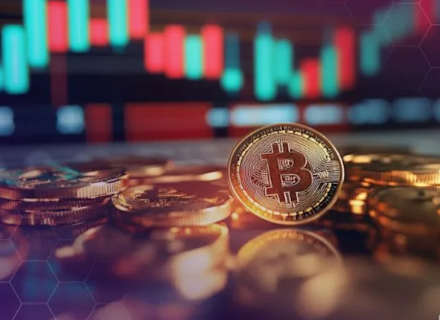Blockchain-Driven GDP Reporting: A New Era for Economic Forecasting and Fintech Innovation
- U.S. Department of Commerce plans to publish GDP data on blockchain, leveraging its tamper-proof, decentralized architecture to enhance transparency and data integrity. - Blockchain-enabled real-time GDP reporting reduces data lag and noise, enabling dynamic forecasting models and faster policy responses compared to traditional delayed reports. - The initiative creates investment opportunities for fintech firms (e.g., IBM, Snowflake) and MLaaS providers (e.g., AWS, Google Cloud) in blockchain infrastruct
The U.S. Department of Commerce's recent announcement to publish GDP data on a blockchain marks a seismic shift in how economic statistics are generated, shared, and utilized. By leveraging blockchain's tamper-proof, decentralized architecture, the initiative aims to address long-standing concerns about data integrity and transparency. This move is not just a technological upgrade—it's a catalyst for redefining economic forecasting models and unlocking new investment opportunities in fintech and data analytics.
The Disruption of Traditional Forecasting Models
For decades, economists have relied on models like ARIMA (AutoRegressive Integrated Moving Average) and machine learning algorithms to predict GDP trends. These models, however, are constrained by the limitations of their input data: delays in reporting, potential inaccuracies, and centralized control over data sources. Blockchain-enabled real-time GDP reporting eliminates these bottlenecks by providing immutable, timestamped data that is instantly accessible to all stakeholders.
Studies from 2023–2025 highlight how blockchain integration enhances forecasting accuracy. For instance, hybrid models combining ARIMA with LSTM (Long Short-Term Memory) neural networks have shown improved performance when trained on blockchain-verified data. A 2025 study on cryptocurrency price forecasting demonstrated that ARIMA underestimated volatility but achieved better alignment with actual outcomes when paired with real-time blockchain data. Similarly, ensemble methods like Random Forest and Gradient Boosting have outperformed traditional models in capturing non-linear patterns in GDP-related datasets.
The key advantage lies in blockchain's ability to reduce lag and noise. Traditional GDP reports are released with a delay of weeks or months, creating a gap between data availability and decision-making. Real-time blockchain data allows models to adapt dynamically, enabling more responsive policy adjustments and market strategies.
Investment Opportunities in Fintech and Data Analytics
The shift to blockchain-based GDP reporting creates a fertile ground for fintech and data analytics firms. Here's how:
Blockchain Infrastructure Providers: Companies that develop or maintain blockchain platforms for government and enterprise use stand to benefit. For example, firms like IBM (IBM) and Microsoft (MSFT) are already partnering with governments on blockchain projects. Their expertise in secure data management positions them to capitalize on the U.S. Department of Commerce's initiative.
Data Analytics Platforms: Real-time GDP data will require advanced analytics tools to process and interpret the information. Firms like Palantir Technologies (PLTR) and Snowflake (SNOW) are well-positioned to offer scalable solutions for real-time data processing and visualization.
Machine Learning-as-a-Service (MLaaS) Providers: As forecasting models evolve, demand for cloud-based ML tools will surge. Amazon Web Services (AMZN) and Google Cloud (GOOGL) are already integrating blockchain data into their AI/ML frameworks, offering a competitive edge to clients in finance and economics.
Cybersecurity and Compliance Firms: Blockchain's transparency does not eliminate the need for robust security. Companies like CrowdStrike (CRWD) and Okta (OKTA) will play a critical role in ensuring that real-time data streams are protected from cyber threats and regulatory scrutiny.
Strategic Considerations for Investors
While the potential is vast, investors must navigate risks. The success of blockchain-based GDP reporting hinges on the accuracy of the underlying data. If the Department of Commerce's data collection methods remain flawed, even the most advanced models will inherit those errors. Additionally, regulatory uncertainty around blockchain adoption could slow implementation.
However, the long-term outlook is compelling. The U.S. initiative aligns with global trends, such as Estonia's blockchain-based e-Health system and California's digitized car title project. These precedents suggest that blockchain's role in public administration is here to stay.
Conclusion: A Call to Action
The U.S. Department of Commerce's blockchain-driven GDP reporting is more than a policy experiment—it's a harbinger of a data-centric future. For investors, this represents an opportunity to back the technologies and companies that will redefine economic forecasting and financial services. Prioritize firms with strong R&D in blockchain, AI, and real-time data analytics. Diversify across infrastructure providers, analytics platforms, and cybersecurity solutions to hedge against sector-specific risks.
As the line between traditional economics and digital innovation blurs, those who adapt early will reap the rewards. The future of economic forecasting is not just about numbers—it's about trust, transparency, and the tools that make them possible.
Disclaimer: The content of this article solely reflects the author's opinion and does not represent the platform in any capacity. This article is not intended to serve as a reference for making investment decisions.
You may also like
Mars Morning News | SEC Expected to Issue "Innovation Exemptions" for the Crypto Industry in "About a Month"
The SEC is expected to issue an innovation exemption for the crypto industry. The UK "Digital Assets and Other Property Act" has come into effect. BlackRock's CEO revealed that sovereign wealth funds are buying bitcoin. Bank of America recommends clients allocate to crypto assets. Bitcoin selling pressure is nearing its end. Summary generated by Mars AI. The accuracy and completeness of this summary are still being improved as the Mars AI model continues to iterate.

a16z: Inefficient governance and dormant tokens pose a more severe quantum threat to BTC.
Deep Reflection: I Wasted Eight Years in the Crypto Industry
In recent days, an article titled "I Wasted Eight Years in the Crypto Industry" has garnered over a million views and widespread resonance on Twitter, directly addressing the gambling nature and nihilistic tendencies of cryptocurrencies. ChainCatcher now translates this article for further discussion and exchange.
